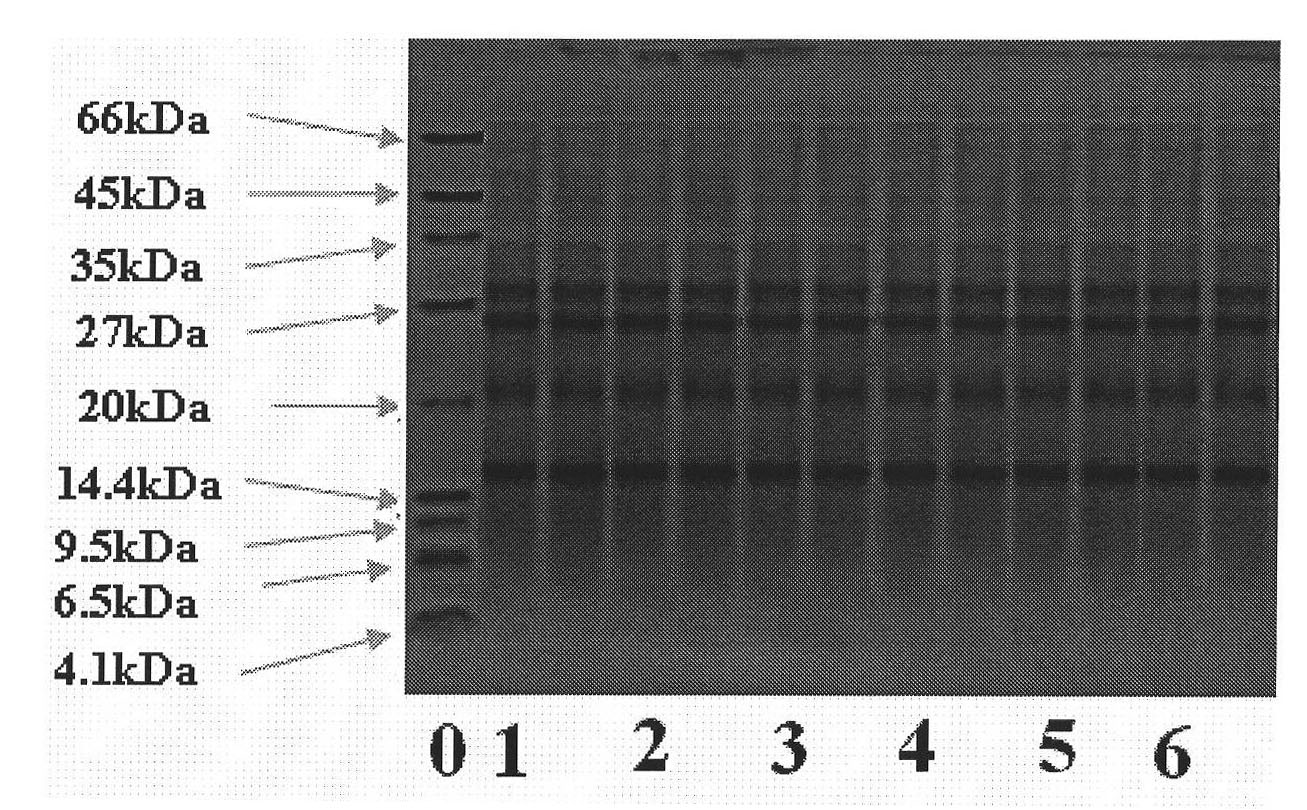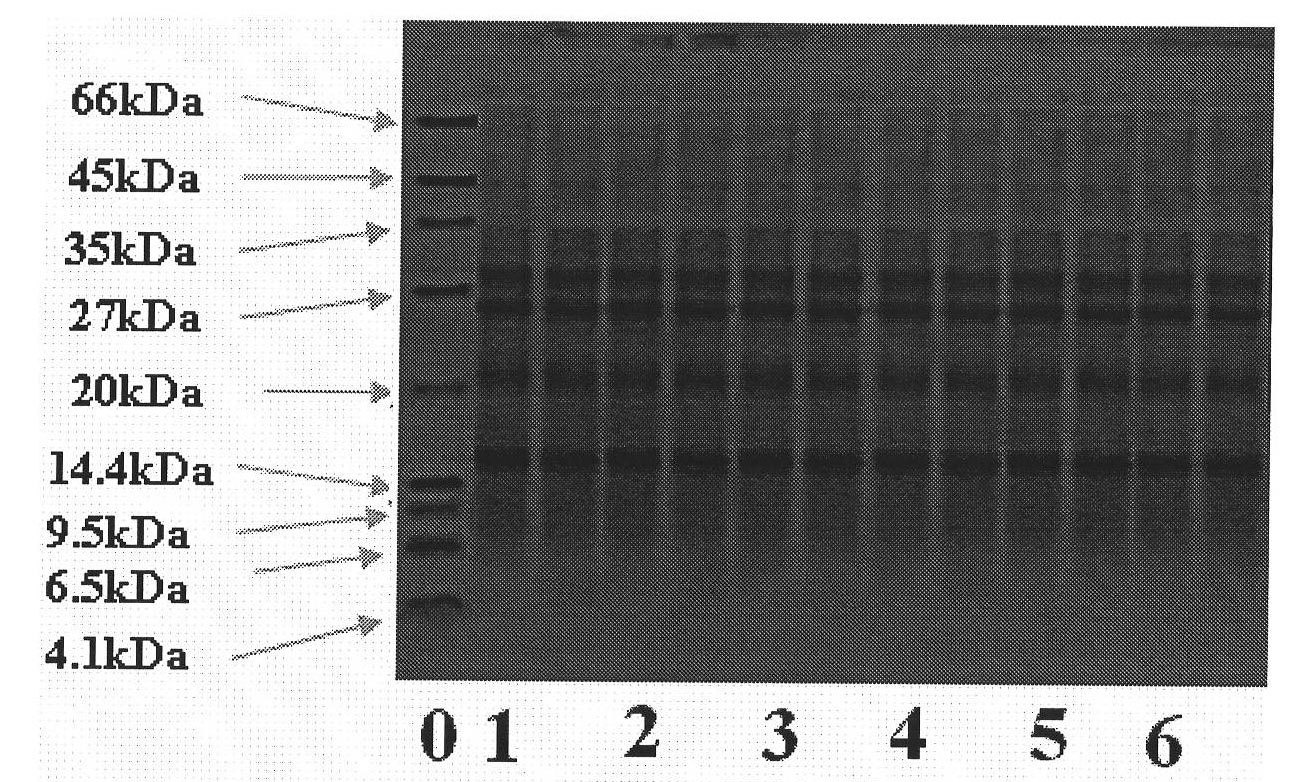Method for extracting natural antitumor active protein and polypeptide from chickpea bean
A protein and chickpea technology, applied in the field of extracting natural anti-tumor active proteins and peptides, can solve problems such as unclear functional factors
- Summary
- Abstract
- Description
- Claims
- Application Information
AI Technical Summary
Problems solved by technology
Method used
Image
Examples
Embodiment 1
[0025] Preparation of chickpea watercress:
[0026] Wash 1kg of chickpeas to remove foreign matter, soak for 1h;
[0027] Put the cleaned and soaked chickpeas into the bean sprouts box to germinate. The temperature of the bean sprouts box is 15°C, the water temperature is 20°C, the watering time is 3 seconds, the watering interval is 2 hours, and the germination time is 4 days;
[0028] Separate the sprouts and watercress of 4-day-germinated chickpeas and dry them separately;
[0029] The dried chickpea watercress is crushed, passed through a 10-mesh sieve, and degreased by cold soaking with n-hexane, and the obtained degreased powder is set aside;
[0030] Extraction of proteins and peptides:
[0031] Take 100 grams of defatted chickpea watercress powder and grind it with liquid nitrogen, then use a phosphate buffer solution with a concentration of 0.1mol / L and a pH of 6.0 to extract with stirring at a temperature of 4°C for 2 hours, filter the extract with gauze, and then ...
Embodiment 2
[0036] Preparation of chickpea watercress:
[0037] Wash 1kg of chickpeas to remove foreign matter, soak for 4 hours;
[0038] Put the cleaned and soaked chickpeas into the bean sprouts box to germinate. The temperature of the bean sprouts box is 20°C, the water temperature is 15°C, the watering time is 5 seconds, the watering interval is 6 hours, and the germination time is 3 days;
[0039] Separate the sprouts and watercress of the 3-day-germinated chickpeas and dry them separately;
[0040] The dried chickpea watercress is crushed, passed through a 40-mesh sieve, and degreased by cold soaking with n-hexane, and the obtained degreased powder is set aside;
[0041] Extraction of proteins and peptides:
[0042] Take 100 grams of defatted chickpea watercress powder and grind it with liquid nitrogen, then use a phosphate buffer solution with a concentration of 0.05mol / L and a pH of 7.0 to extract with stirring at a temperature of 4°C for 1 hour, filter the extract with gauze, ...
Embodiment 3
[0047] Preparation of chickpea watercress:
[0048] Wash 1kg of chickpeas to remove foreign matter, soak for 5 hours;
[0049] Put the cleaned and soaked chickpeas into the bean sprouts box to germinate. The temperature of the bean sprouts box is 25°C, the water temperature is 25°C, the watering time is 7 seconds, the watering interval is 4 hours, and the germination is 5 days;
[0050] Separate the sprouts and watercress of the 5-day-germinated chickpeas and dry them separately;
[0051] The dried chickpea watercress is crushed, passed through a 60-mesh sieve, and degreased by cold soaking with n-hexane, and the obtained degreased powder is set aside;
[0052] Extraction of proteins and peptides:
[0053] Take 100 grams of defatted chickpea watercress powder and grind it with liquid nitrogen, then use a phosphate buffer solution with a concentration of 0.07mol / L and a pH of 5.0 to extract with stirring at a temperature of 4°C for 3 hours, filter the extract with gauze, and ...
PUM
 Login to View More
Login to View More Abstract
Description
Claims
Application Information
 Login to View More
Login to View More - R&D
- Intellectual Property
- Life Sciences
- Materials
- Tech Scout
- Unparalleled Data Quality
- Higher Quality Content
- 60% Fewer Hallucinations
Browse by: Latest US Patents, China's latest patents, Technical Efficacy Thesaurus, Application Domain, Technology Topic, Popular Technical Reports.
© 2025 PatSnap. All rights reserved.Legal|Privacy policy|Modern Slavery Act Transparency Statement|Sitemap|About US| Contact US: help@patsnap.com



